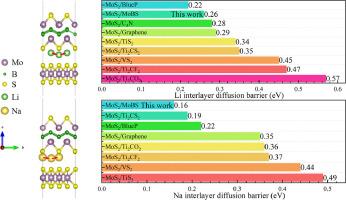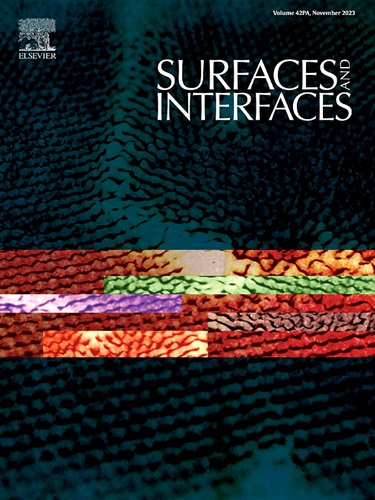显著促进层间离子扩散,将 MoS2 /MoBS 异质结构用作高性能锂/钽离子电池阳极材料
IF 5.7
2区 材料科学
Q2 CHEMISTRY, PHYSICAL
引用次数: 0
摘要
作为新型二维材料家族的一员,官能化 MoB(MBene)因其优异的机械性能和金属性而作为储能材料备受关注。在此,我们旨在利用 MBene 的优异特性,通过设计 MoS2 /MoBS 异质结构,为锂离子电池/纳离子电池开发新的电子材料。我们的研究重点是通过第一原理计算研究其结构稳定性、机械性能和电化学性能。高杨氏模量、稳健的结构稳定性和金属性防止了电极粉化,保证了电池的循环稳定性。令人印象深刻的是,Li 原子和 Na 原子的层间扩散势垒仅为 0.26 和 0.16 eV,优于其他基于 MoS2 的异质结构。计算得出的锂原子开路电压为 0.01-1.83 V,Na 原子开路电压为 0.02-1.28 V,因此该异质结构适合用作正极材料。此外,与单层 MoS2(335 mAh/g)和 MoBS(193 mAh/g)相比,异质结构形成的电子转移提高了锂原子的可逆比容量(376 mAh/g)。这些发现充分凸显了 MoS2/MoBS 异质结构作为锂/纳离子电池阳极材料的潜力。本文章由计算机程序翻译,如有差异,请以英文原文为准。

Significant promotion of interlayer ion diffusion for MoS2 /MoBS heterostructure as high performance Li/Na ion batteries anode material
As a member of the new two-dimensional materials family, functionalized MoB (MBene) attracts great interest as energy storage materials due to their excellent mechanical properties and metallicity. Here, we aim to leverage the superior properties of MBene to develop new promising electron materials for Li/Na-ion batteries by designing the MoS2 /MoBS heterostructure. Our investigation focuses on the structural stability, mechanical and electrochemical properties by first-principles calculation. The high Young's modulus, robust structural stability and metallicity prevent the electrode pulverization and guarantee cycle stability of battery. Impressively, the interlayer diffusion barriers of Li and Na atoms are only 0.26 and 0.16 eV, outperforming other MoS2-based heterostructures. With calculated open circuit voltage of 0.01–1.83 V for Li atoms and 0.02–1.28 V for Na atoms, the heterostructure is suitable for deployment as an anode material. Besides, the reversible specific capacity (376 mAh/g) of Li atoms is improved by the electron transfer caused by the formation of heterostructure compared to that of monolayer MoS2 (335 mAh/g) and MoBS(193 mAh/g). These findings fully underline the potential of MoS2/MoBS heterostructure as anode material of Li/Na-ion batteries.
求助全文
通过发布文献求助,成功后即可免费获取论文全文。
去求助
来源期刊

Surfaces and Interfaces
Chemistry-General Chemistry
CiteScore
8.50
自引率
6.50%
发文量
753
审稿时长
35 days
期刊介绍:
The aim of the journal is to provide a respectful outlet for ''sound science'' papers in all research areas on surfaces and interfaces. We define sound science papers as papers that describe new and well-executed research, but that do not necessarily provide brand new insights or are merely a description of research results.
Surfaces and Interfaces publishes research papers in all fields of surface science which may not always find the right home on first submission to our Elsevier sister journals (Applied Surface, Surface and Coatings Technology, Thin Solid Films)
 求助内容:
求助内容: 应助结果提醒方式:
应助结果提醒方式:


